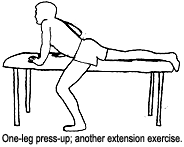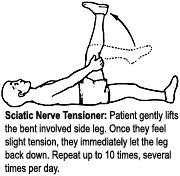How can you treat the nerves when they show excessive nerve tension and increased sensitivity? Read my previous article1 for a synopsis of altered physiology of the nerves and using neurodynamic testing to assess this phenomenon.
What should we call this "state" as it relates to the sciatic nerve? One useful description of this state is altered mechanical sensitivity. I like this term, as it implies that the problem has a mechanical component. Altered neurodynamics (Butler's description) implies that the problem relates to mobility. Neural pain would mean the pain comes from the nerve. I discussed nociceptive vs. neuropathic pain extensively in the previous article.
What causes this nerve tension? We can begin with bulged discs and degenerative changes that affect the spinal canal or neural foramina. We also can look at other possible changes, including edema and hypersensitivity, which affect mobility and irritability of the nerve and its sheaths. It's useful to have some idea what the source is, but in reality, we don't always have to know the source to help solve the problem.
 What can we do to change neural tension? Whatever you do for correction, I suggest you use the neurodynamic model to assess and then reassess. In other words, observe for changes in the quality of the straight-leg raise as an objective measure of neural tension changes. I've said this over and over again. If you are an AK doc, don't just believe your muscle tests. If you are an Activator doc, don't just use your leg checks. You need to look at both the patient's immediate subjective changes and an objective physical exam test that is outside of your technique system to truly evaluate what you have done.
What can we do to change neural tension? Whatever you do for correction, I suggest you use the neurodynamic model to assess and then reassess. In other words, observe for changes in the quality of the straight-leg raise as an objective measure of neural tension changes. I've said this over and over again. If you are an AK doc, don't just believe your muscle tests. If you are an Activator doc, don't just use your leg checks. You need to look at both the patient's immediate subjective changes and an objective physical exam test that is outside of your technique system to truly evaluate what you have done.
For any increase in sciatic neural tension, the first procedure I usually try is a basic McKenzie protocol. Find the patient's directional bias and teach them to use it for self-correction. The direction usually will be extension for lumbar sciatic nerve issues. The exercise or positioning is simple and the model has a good evidence base - it gives even a "motor moron" patient something useful to do. Knowing the patient gets relief or centralization with extension also guides the rest of your exercise protocol on that patient. For example, they should stretch the piriformis muscle while maintaining the lumbar lordosis, rather than in lumbar flexion.
Have the patient bend forward several times and see if this increases or peripheralizes their pain. Have the patient bend backward several times, either prone or standing, and see if this relieves or centralizes their pain. If they are not sure, you can use the straight-leg raise to reassess. My understanding of centralization has become broader. Centralization means the pain moves proximally, from the calf up into the hamstring, or even from the lateral buttock to medial buttock. Centralization also can mean the leg pain or low back pain improves.
 I often add one variation to the McKenzie exercise model, especially when the patient has unilateral restriction over the sacral base, or lumbosacral junction. This is the one-leg press-up. This increases the extension unilaterally. The patient usually will know right away if this feels good to them, and you will feel a softening in the unilateral joint and muscular-tension levels.
I often add one variation to the McKenzie exercise model, especially when the patient has unilateral restriction over the sacral base, or lumbosacral junction. This is the one-leg press-up. This increases the extension unilaterally. The patient usually will know right away if this feels good to them, and you will feel a softening in the unilateral joint and muscular-tension levels.
The classic chiropractic and soft-tissue approach is to assess and correct the "container." By the "container," I mean the joint restrictions and soft-tissue changes that occur in the regions surrounding or potentially affecting the sciatic nerve. Joint issues could include the lumbar facet joints, the sacroiliac joints, the hip (coxa-femoral) joint, or the coccyx. An abbreviated list of involved soft tissues would start with the piriformis, the sacrotuberous ligaments or hamstring origin, as well as the quadratus femoris. Don't forget to assess for Janda's lower-crossed syndrome, visceral fascial dysfunction in the lower abdomen, psoas problems and/or abdominal scars. (I'll assume the reader knows how to address these issues and suggest you read my previous articles on these topics.)
A big concern with any sciatic nerve issue is axial compression of the lumbar spine. You could buy an expensive table and use that type of decompression. I prefer lower-tech decompression, using either flexion-distraction tables or the vertebral distraction pump. I also emphasize teaching the patient to decompress themselves several times daily and to enhance their core stability. I am using the word compression to imply a functional state that can be indicated by midline spinous processes or interspinous tenderness. I addressed this topic at length in a previous article (www.chiroweb.com/archives/25/01/08.html).
I already have recommended Butler's model3 of assessing neurodynamics in my previous article on nerves. Butler also has developed a series of both in-office and home routines to either gently or vigorously move the nerves through their congested canals. Start with the gentle nerve-gliding methods and then add the more aggressive nerve "tensioners," as tolerated.
I have illustrated a couple of these and featured them in the YouTube video. I suggest you always err toward a conservative, gentle approach. Stretching a nerve too strongly can set off further sciatic irritation. In the glides, the patient should feel no pain or nerve tension. In the tensioner, the patient should "feather" up to the edge of tension/pain, and then back off and repeat.
 In the office, you can add tethering to make these nerve-mobility motions more specific. (I learned this from a seminar4 but I don't think this work has been published anywhere.) Here's the concept: First, find the restricted area in the neural axis, whether it's a dural or joint restriction. Next, "tether" the area with manual pressure. Finally, have the patient add the nerve glide/nerve tensioning. Here is a good way to do this for sciatica. Assess the lower lumbar and sacral spine for joint restrictions. Have the patient supine and have them perform the nerve tension stretch, lifting their lower leg into extension, thus stretching the sciatic nerve. The doctor simultaneously presses the joint into either long-axis distraction or side-bending. In other words, I either pull the spinous process superior or I pull it sideways. For side-bending in a R sciatica, I will sit on the left side of the supine patient, reach around underneath them, hook my fingers around the R side of the spinous process of L4 or L5, pull the spinous toward me, and then have the patient perform the nerve glide. I will feel the pressure against my fingers increase as the patient moves their leg. I also can place my fingers between the midline sacral base and L5, or between the spinouses of L4 and L5, and provide a superior pressure, distracting the specific involved level.
In the office, you can add tethering to make these nerve-mobility motions more specific. (I learned this from a seminar4 but I don't think this work has been published anywhere.) Here's the concept: First, find the restricted area in the neural axis, whether it's a dural or joint restriction. Next, "tether" the area with manual pressure. Finally, have the patient add the nerve glide/nerve tensioning. Here is a good way to do this for sciatica. Assess the lower lumbar and sacral spine for joint restrictions. Have the patient supine and have them perform the nerve tension stretch, lifting their lower leg into extension, thus stretching the sciatic nerve. The doctor simultaneously presses the joint into either long-axis distraction or side-bending. In other words, I either pull the spinous process superior or I pull it sideways. For side-bending in a R sciatica, I will sit on the left side of the supine patient, reach around underneath them, hook my fingers around the R side of the spinous process of L4 or L5, pull the spinous toward me, and then have the patient perform the nerve glide. I will feel the pressure against my fingers increase as the patient moves their leg. I also can place my fingers between the midline sacral base and L5, or between the spinouses of L4 and L5, and provide a superior pressure, distracting the specific involved level.
We've outlined several ways to release sciatic nerve tension, both with home-exercise and in-office procedures. Next month, we'll complete this series on the sciatic nerve, going over Jean Pierre Barral's manual therapy to the nerve sheath, and further exploring combining dural release with neurodynamics.
References
- Heller M. "Understanding and Diagnosis of Nerve Related Pain." Dynamic Chiropractic, Mar. 25, 2008.
- Heller M. Sciatic Nerve Tension, Assessment and Self Treatment (video). www.youtube.com/watch?v=5GddMQdcgNA.
- Nuero-Orthopedic Institute Web site: www.noigroup.com.
- Bookhout M. Exercise as an Adjunct to Manual Medicine. Seminar, 1998.
Click here for more information about Marc Heller, DC.






